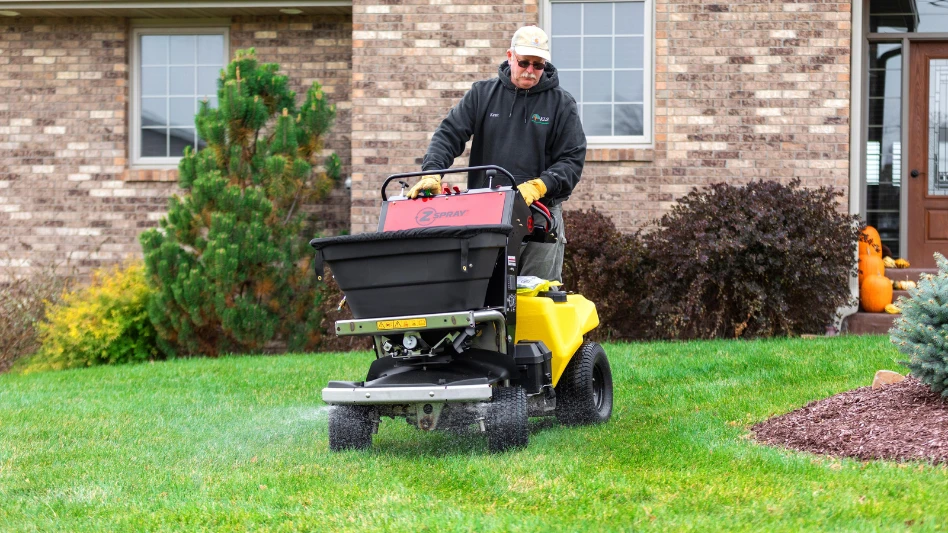EDITOR'S NOTE: To view an online only sidebar please click here: ONLINE ONLY SIDEBAR: Xeriscape Plant Selection.
A casual observer might steal a prolonged stare at a landscape decorated with splashes of color and layers of leafy texture. Perhaps the onlooker notices carefully placed, decorative hardscape features that build layers into the site, groundcover tumbling over each level.
This unassuming eye sees variety - flair. Not Xeriscape.
A motorist might glance at wild grasses on a road median or catch a glimpse of a far-off slope, scattered with thriving plants.
This unassuming eye sees ordinary grasses, not Xeriscape.
"When people say Xeriscape, homeowners think of rocks, gravel and a cactus - that’s only a small component of Xeriscaping, but it’s not what I think of in the gardens I create," clarified Jeff Powers, co-owner, Earthscape, Costa Mesa, Calif.
Conscientious planting does not translate to installing a dirtbed, he pointed out. Climate-specific landscape doesn’t mean reinventing a desert, and water-conserving varieties aren’t limited to cacti and dusty hedges. The Xeriscape concept is contrary to these misinterpretations, and more contractors and clients are embracing its environmental advantages.
"They can be very colorful, aromatic, dynamic and have a lot of color and pattern activity," Powers described. "There is a dialogue that forms between the site and the plants, and a relationship that forms between the site and the homeowner who lives there, and that part of it makes it ever-changing."
Slowly, Xeriscape’s overall image is changing as well.
TAKING STEPS. Xeriscape is not foreign to the Southwest, having originated in Denver, Colo., in the early 1980s. Since then, communities facing water use restrictions began emphasizing drought-tolerant planting. Xeriscaping involves water conservation through creative, appropriate landscaping and water management, including recommendations for plants, irrigation, soil preparation and maintenance.
"You design the landscaping so that it survives best in the condition that you’re dealing with, whether it’s temperature, insects, pests or runoff issues. It’s climate-appropriate landscape," defined Vickie Driver, water resources specialist, San Diego County Water Authority, San Diego, Calif. "It also has more benefits than water conservation. If you use appropriate plant materials for your landscape, they are much more likely to be able to resist local insect and plant diseases, so they are healthier. They will need less maintenance and less fertilizer."
To accomplish a landscape that achieves environmental and aesthetic harmony, attentive installation measures are a necessary prerequisite, Driver stressed.
| Step By Step |
|
In its strictest sense, Xeriscape requires implementing seven installation and maintenance commandments (see Step by Step at right).
These steps provide an installation outline for contractors, said Paul Littlepage, owner, Littlepage Landscaping, San Clemente, Calif. For example, contractors who skip proper soil preparation will suffer plant loss, he added, noting that many landscape companies are discouraged by the method’s requirements.
No cheating, Littlepage warned, "or it will show. A lot of landscapers don’t want to do Xeriscape because they can’t slam it into the ground like they can another job," he said. "You have to be careful, using proper soil amendments and post-installation control with watering, mulching the ground and keeping the bugs off plants."
These demands can boost landscape prices 10 to 15 percent for the client, but long-term maintenance and water savings justify the investment. A customer with conscientious plantings can realize an 80-percent water savings, Littlepage added.
This is why more southwest municipalities are supporting low water use landscape installation, and some of them, such as Denver, Colo., offer water bill credits to homeowners who install Xeriscape. Other cities, such as Phoenix, Ariz., distribute a low water use plant list that suggests climate-appropriate trees, shrubs and grasses. (Visit this article at www.lawnandlandscape.com for a list of Xeriscape plants.)
To meet the surging interest in low water use planting, nurseries are offering a wider selection of native plants, Littlepage observed. He noticed a local grower’s fattening catalogue, where pages dedicated to native plants and grasses have increased from four to 26 pages in the last five years.
An extended palate allows contractors more creative liscense to bend Xeriscape’s desert-scape preconceptions.
"We show people how they can have water-efficient plantings, and at the same time, have an ever-green, flowering landscape," Jewett said. He calls this a "mini-oasis," concentrating lush plants in visible areas near the clients’ homes, and filling in remaining areas with low water use grasses.
| Reverse Thinking |
Most contractors associate Xeriscape with lack of water, however, wet areas also can benefit from climate-appropriate landscape, pointed out Tom Fochtman, co-owner, CoCal Landscape Services, Denver, Colo. By strategically placing plants in areas with heavy runoff, Xeriscape plants can thrive. "You have drainage situations that receive a lot of water through rain and irrigation runoff, and there’s a lot of plant material and grasses that can be used there that do not receive irrigation water," he explained. "It is kind of reverse thinking." Using a Xeriscape state of mind, drainage areas can be beautified. "You are not going to supplement the area wth any additional water, and the plant material will survive and thrive with the natural precipitation and runoff it receives," he noted. |
GROUND RULES. Customers’ expectations for their property are often unrealistic when choosing climate-appropriate plants, Littlepage said. "Most people who want Xeriscape are not really familiar with it," he noted. "It is a different look, and although you can get close to a lush, green look with certain plants, overall, the plant material tends to be a little less brilliant."
Grass might not be green year-round, and flowering plants might not radiate color immediately. Attractive, mature Xeriscape landscapes take time, he stressed.
"It’s a dance in a way," Littlepage compared. Wind indicates a need for stronger plants, while a prime ocean view calls for low-growing groundcover. Hillsides require deep-rooted plants to stabilize the earth, and drainage areas signal a danger zone, he said.
Then, there are weather concerns.
"There are certain times of the year where we can’t do drought-tolerant landscaping, because the plants don’t transplant well," Littlepage said, adding that high temperatures are not ideal conditions for planting, as roots can easily dry out before they adapt to the soil.
Communicating these plant needs with customers is crucial, Littlepage reminded. Just as maintenance sustains health in traditional plantings, low-maintenance does not mean no maintenance. Ironically, clients tend to over-water Xeriscape plants.
"I try to set up a watering schedule for customers," he said. "The drip irrigation system will do the watering and that’s all you need during certain periods. I usually break down the calendar to spring, summer, fall and winter. You might not have to water at all in the winter, and it’s hard for people to get used to that."
Most customers have little difficulty adjusting to the sparse mowing schedule, which requires cutting once a month or every other week for a manicured look with native California Buffalo grass, Powers noted.
Nevertheless, Littlepage checks on installations to examine for signs of stress. "If they show signs of stress, why? Lack of water? Too much water? Fertilizer?" he listed, adding that clients can take a relaxed approach to caring for their properties if the materials were installed correctly.
| ONLINE ONLY SIDEBAR: Xeriscape Plant Selection |
Native Grasses Non-Native Grasses Trees Medium Trees Small Trees Shrubs Flowers and Ground Covers Source: North Dakota State University Extension Service |
DEDICATED DESIGN. Planting success originates in design plans. "Design is critical," emphasized Tom Fochtman, co-owner, CoCal Landscape Services, Denver, Colo. "It doesn’t matter how well you install it, if it is designed poorly it will not be successful."
He compared Xeriscape design to a perennial bed, where overlapping varieties provide year-round interest. Now, with more plant choices, contractors can add texture and dimension with leaves, for example.
Xeriscape is a more marketable, appealing option for residential clients than in the past, however, some commercial clients hesitate to install drought-tolerant plants on corporate properties, he added.
"Turf is accepted as that corporate campus look," Fochtman explained. "Everyone likes the look of the mowed fairway."
A heightened interest in environmental issues and an expanding awareness of Xeriscape’s benefits is feeding the niche method, Littlepage said. Powers added that reaction generally follows urgent conditions.
"In the long-run, drought-tolerant landscape is in the best interest of our desert environment, and now that water use is becoming more of a concern it will continue to grow more popular," he predicted.
The author is Assistant Editor of Lawn & Landscape magazine.

Explore the April 2001 Issue
Check out more from this issue and find your next story to read.
Latest from Lawn & Landscape
- PERC helps debut propane direct-injection fuel system at ACT Expo 2025
- Retargeting Ads – A Secret Weapon for Growing Your Lawn Care Business
- Leading a growing company
- Project EverGreen launches Clean Air Calculator
- Rain Bird acquires smart lawn care company OtO from Toronto
- PBI-Gordon names Marvin as VP of research and development
- Mean Green rolls out Vanquish Autonomous mower
- Focal Pointe launches new podcast series





